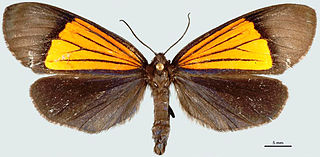
Notodontidae is a family of moths with approximately 3,800 known species. The family was described by James Francis Stephens in 1829. Moths of this family are found in all parts of the world, but they are most concentrated in tropical areas, especially in the New World.

Dioptinae is a subfamily of the moth family Notodontidae.

Notascea is a genus of moths of the family Notodontidae. It consists of the following species:

Scea subcyanea is a moth of the family Notodontidae. It is found in Peru.
Eremonidia is a monotypic moth genus of the family Notodontidae. Its only species, Eremonidia mirifica, is known from two mountain ranges in the south-western part of the Dominican Republic. Both the genus and species were first described by John E. Rawlins and James S. Miller in 2008.

Disphragis is a genus of moths of the family Notodontidae erected by Jacob Hübner in 1820. The genus is confined to the New World and it contains about 137 species.
Erbessa lamasi is a moth of the family Notodontidae first described by James S. Miller in 2008. It is found in south-eastern Peru.
Erbessa tegyroides is a moth of the family Notodontidae first described by James S. Miller in 2008. It is found in south-eastern Peru.
Erbessa thiaucourti is a moth of the family Notodontidae first described by James S. Miller in 2008. It is found in French Guiana.
Phaeochlaena costaricensis is a moth of the family Notodontidae first described by James S. Miller in 2008. It is found in Costa Rica and Panama.
Polypoetes wagneri is a moth of the family Notodontidae first described by James S. Miller in 2008. It is found in Costa Rica.
Brachyglene fracta is a moth of the family Notodontidae first described by James S. Miller in 2008. It is endemic to north-central Venezuela.
Chrysoglossa fumosa is a moth of the family Notodontidae first described by James S. Miller in 2008. It is found in Panama.
Chrysoglossa norburyi is a moth of the family Notodontidae first described by James S. Miller in 2008. It is found in Costa Rica.
Nebulosa huacamayensis is a moth of the family Notodontidae first described by James S. Miller in 2008. It is found in cloud-forest habitats in Ecuador.
Nebulosa rudicula is a moth of the family Notodontidae first described by James S. Miller in 2008. It is found along the Pacific slope of the Cordillera de Talamanca in Costa Rica.
Dolophrosyne sinuosa is a moth of the family Notodontidae first described by James S. Miller in 2008. It is found in the Cosnipata Valley east of Cuzco in Peru.
Euchontha moyobamba is a moth of the family Notodontidae first described by James S. Miller in 1989. It is found in Peru.
Euchontha carboniptera is a moth of the family Notodontidae first described by James S. Miller in 2008. It is endemic to the eastern slopes of the Peruvian Andes.

Dunama is a genus of moths of the family Notodontidae described by William Schaus in 1912.





